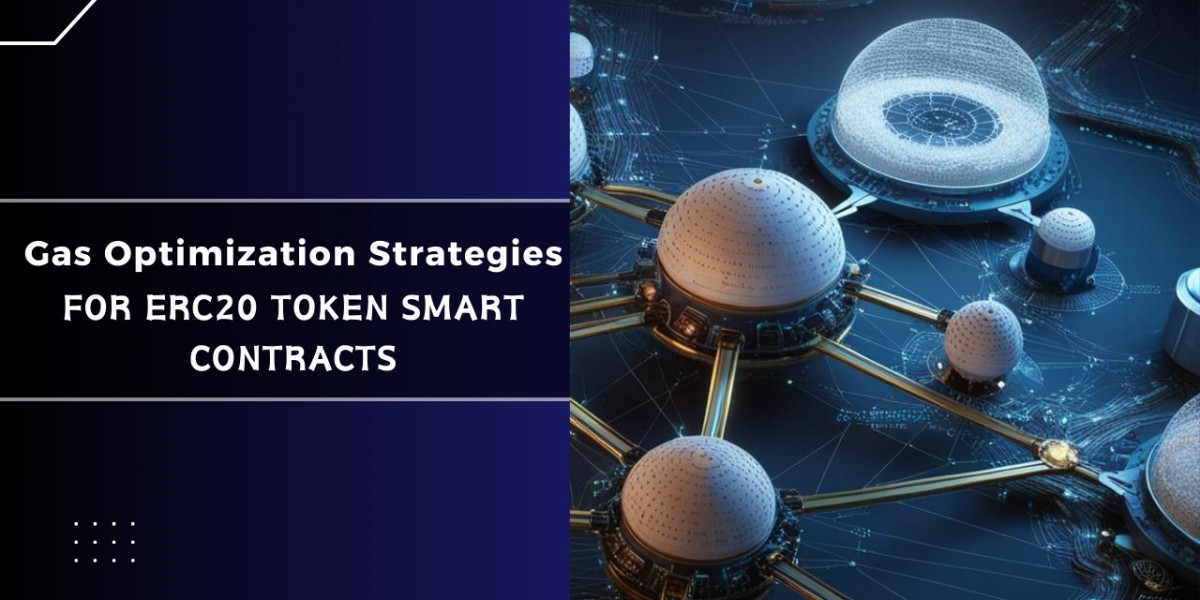Introduction
In the fast-evolving world of blockchain technology, ERC20 tokens have become a cornerstone of decentralized finance (DeFi) and tokenized ecosystems. However, one of the critical challenges developers face when creating ERC20 smart contracts is optimizing gas usage. Gas fees can impact the usability and attractiveness of a token, making it essential to implement strategies that reduce costs without compromising functionality or security.
This blog explores proven gas optimization strategies for ERC20 token smart contracts, providing insights that can help developers build efficient and cost-effective ERC20 token development solutions.
Understanding Gas in Ethereum
Operations executing on the Ethereum blockchain require Gas as their basis for computational effort measurement. A single transaction along with smart contract deployments and function calls requires gas that payments operate through Ether (ETH).
Improving gas usage plays a vital role because excessive gas fees would repel users and diminish adoption while turning routine token transfers into costly operations. Developers understand the gas consumption process better when they implement efficient solutions.
Common Gas Inefficiencies in ERC20 Contracts
The gas costs increase because ERC20 contracts contain several inefficient code components. The first optimization step involves detection of frequent issues within ERC20 contracts for reaching performance optimization.
Redundant state variables: Excessive use of storage variables increases gas consumption.
Unoptimized loops: Iterating over large arrays or performing multiple storage reads can be expensive.
Costly token transfers: Poorly designed transfer functions can inflate transaction fees.
By recognizing these pitfalls, developers can lay the groundwork for a more efficient ERC20 token.
Best Practices for Gas Optimization
Minimize On-Chain Storage
Ethereum charges high prices for storage-related operations. To reduce costs:
Use memory variables instead of storage when possible.
Pack multiple variables into a single storage slot.
Avoid unnecessary storage reads and writes.
Use constant and immutable Keywords
The definition of variables as constant or immutable eliminates unnecessary storage operations which helps to cut down gas expenditure on frequently accessed values.
Optimize Solidity Functions
Function-level optimizations can significantly lower gas fees:
Avoid expensive loops and recursion.
Use calldata instead of memory for function arguments.
Minimize external contract calls and computations within transactions.
Break down complex functions into smaller, more efficient components.
Leverage Events Efficiently
Token transfers and approvals need Events for tracking purposes yet their application must be selective. The emission of additional events leads to increased gas costs for the network. Event logs that remain brief and appropriate help organizations maintain reasonable gas expenditures.
ERC20 Specific Gas Optimization Techniques
When working with ERC20 tokens, some specific strategies can help:
Implement efficient approve and transferFrom functions to minimize redundant state changes.
Use OpenZeppelin’s ERC20 library, which provides optimized and secure implementations.
Reduce gas costs for balance and allowance checks by optimizing storage access patterns.
Consider implementing a gas-efficient batch transfer mechanism for handling multiple transfers in a single transaction.
Advanced Techniques
EIP-2612: Permit Function
Through EIP-2612 users obtain a permit which enables gasless approvals to enhance user experience and decrease transaction expenses. Online approvals through this technique enable users to bypass the requirement of executing on-chain approve transactions.
Proxy Contracts and Upgradeable ERC20 Tokens
The Transparent or UUPS proxy patterns create an upgradeable smart contract framework that omits the need for deploying an entire contract again. The use of proxy patterns through Transparent or UUPS proxies leads to substantial reduction in fees associated with deployment and interaction.
Gas Token Mechanisms
The utilization of gas tokens including Chi Gas Token or GST2 enables developers to accumulate gas at reduced rates for eventual use in high-gas-price periods. The implementation of this method results in substantial financial benefits when applied to repeated transactions.
Real-World Case Studies
Expected gas optimization practices in ERC20 projects become clear through analysis of successful implementations. The reduction of gas fees stems from projects that minimize storage operations, conduct off chain data computations and process multiple token transfers as batches.
The token exchange platform Uniswap optimizes its smart contractual code to cut down state changes and minimize transaction fees for both traders and liquidity providers. The observation of these projects enables developers to implement equivalent optimizations within their own ERC20 token implementation.
Conclusion
The optimization of gas usage in ERC20 token smart contracts serves a dual purpose of both cost reduction and blockchain solution development for scalability and user-friendly performance. Developers who apply the procedures in this blog will produce effective and secure token systems for the thriving decentralized finance market.
The long-term efficiency of Ethereum gas must be achieved through continuous testing and auditing as well as active monitoring of new Ethereum improvement proposals. The competitive advantage and improved user experience of Ethereum network will grow with proactive application of gas optimization techniques as its platform evolves.










